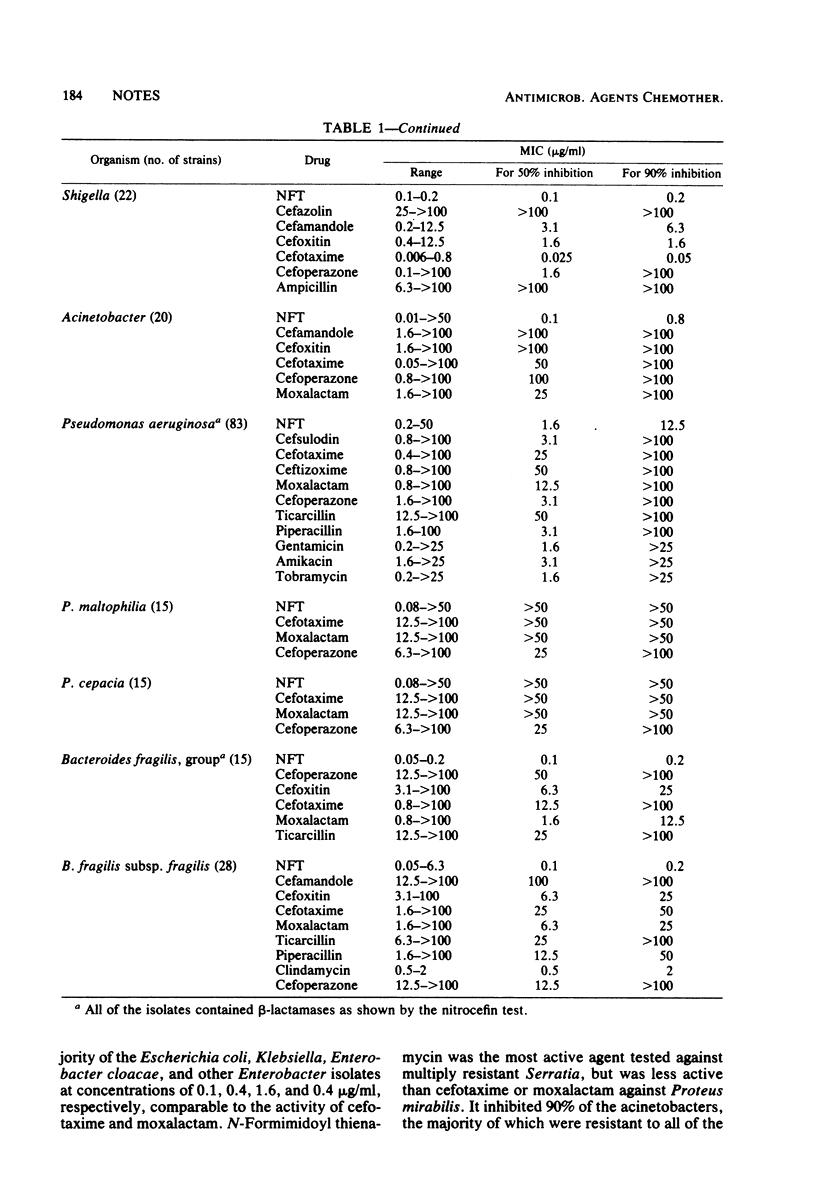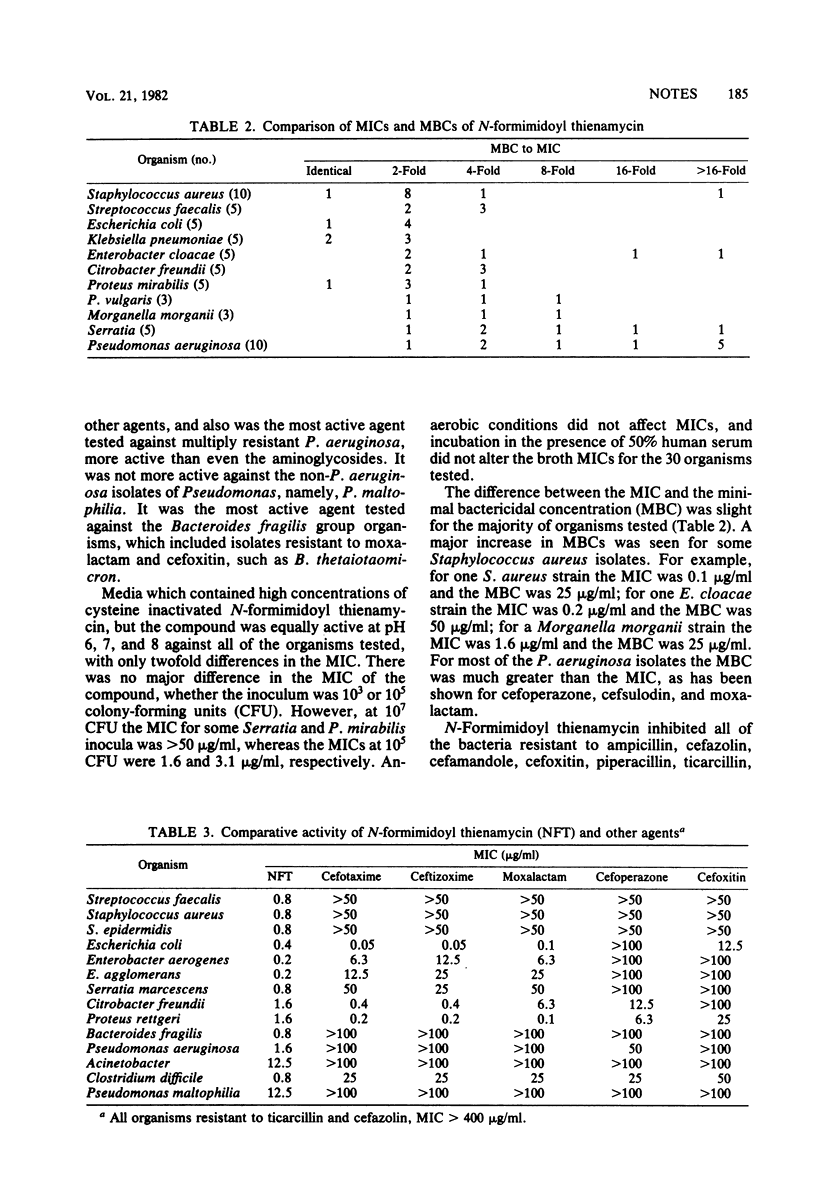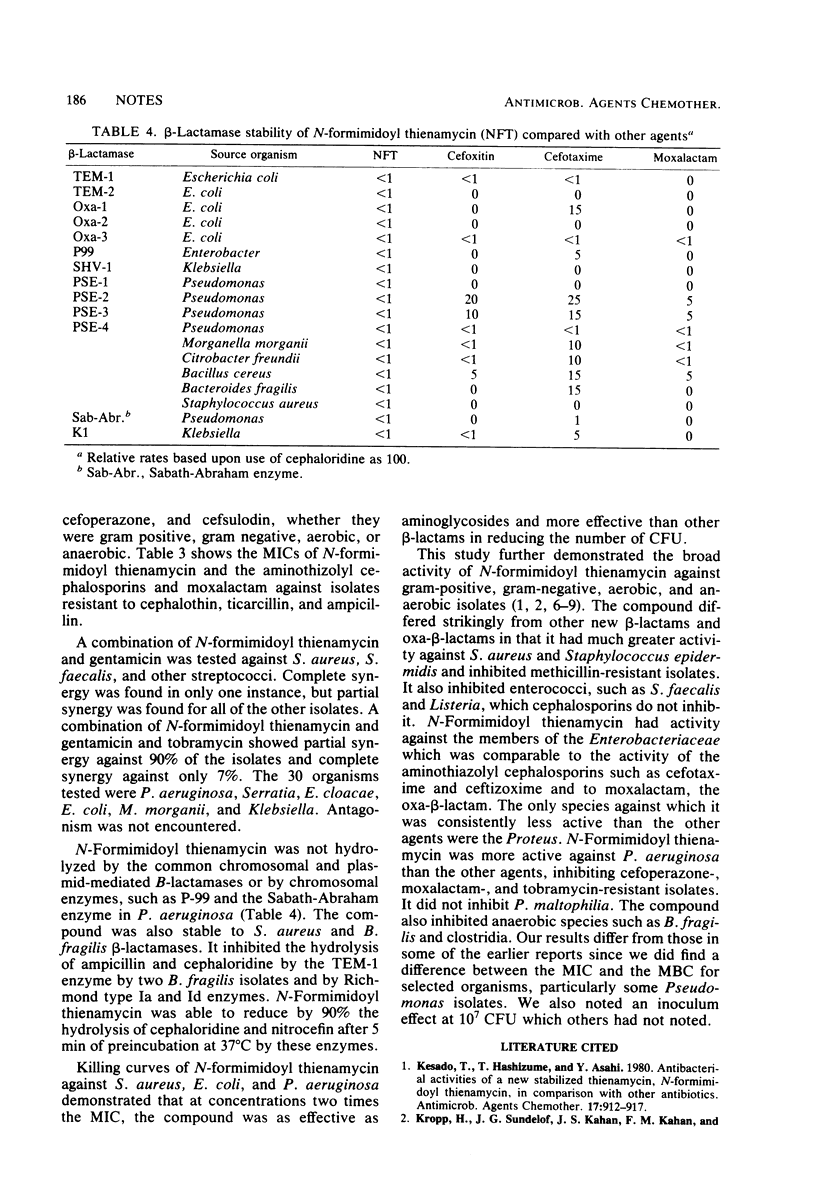Abstract
The in vitro activity of N-formimidoyl thienamycin was determined against 800 gram-positive and gram-negative aerobic and anaerobic bacteria and compared with the activity of cefoxitin, cefazolin, cefamandole, cefotaxime, moxalactam, ampicillin, cefoperazone, and gentamicin. N-Formimidoyl thienamycin inhibited the majority of organisms at concentrations below 1 microgram/ml. It inhibited methicillin-resistant Staphylococcus aureus, Staphylococcus epidermidis, and Streptococcus faecalis. It inhibited beta-lactamase-producing Haemophilus influenzae and Neisseria gonorrhoeae. Unlike other new beta-lactams, it inhibited Listeria. Escherichia coli, Klebsiella pneumoniae, enterobacters, Serratia, indole-positive Proteus, Acinetobacter, Pseudomonas aeruginosa, and Bacteroides resistant to other agents were inhibited. There was minimal effect of inoculum size and aerobic versus anaerobic conditions, and serum had no effect on activity. Most minimal bactericidal concentrations were two- or fourfold greater than the minimal inhibitory concentration. N-Formimidoyl thienamycin showed partial synergy with aminoglycosides against S. aureus, S. faecalis, and many Pseudomonas and Enterobacteriaceae. It was not hydrolyzed by plasmid-mediated and chromosomal beta-lactamases.
Full text
PDF







Selected References
These references are in PubMed. This may not be the complete list of references from this article.
- Kesado T., Hashizume T., Asahi Y. Antibacterial activities of a new stabilized thienamycin, N-formimidoyl thienamycin, in comparison with other antibiotics. Antimicrob Agents Chemother. 1980 Jun;17(6):912–917. doi: 10.1128/aac.17.6.912. [DOI] [PMC free article] [PubMed] [Google Scholar]
- Kropp H., Sundelof J. G., Kahan J. S., Kahan F. M., Birnbaum J. MK0787 (N-formimidoyl thienamycin): evaluation of in vitro and in vivo activities. Antimicrob Agents Chemother. 1980 Jun;17(6):993–1000. doi: 10.1128/aac.17.6.993. [DOI] [PMC free article] [PubMed] [Google Scholar]
- Neu H. C., Aswapokee N., Aswapokee P., Fu K. P. HR 756, a new cephalosporin active against gram-positive and gram-negative aerobic and anaerobic bacteria. Antimicrob Agents Chemother. 1979 Feb;15(2):273–281. doi: 10.1128/aac.15.2.273. [DOI] [PMC free article] [PubMed] [Google Scholar]
- Neu H. C., Aswapokee N., Fu K. P., Aswapokee P. Antibacterial activity of a new 1-oxa cephalosporin compared with that of other beta-lactam compounds. Antimicrob Agents Chemother. 1979 Aug;16(2):141–149. doi: 10.1128/aac.16.2.141. [DOI] [PMC free article] [PubMed] [Google Scholar]
- Tally F. P., Jacobus N. V., Gorbach S. L. In vitro activity of thienamycin. Antimicrob Agents Chemother. 1978 Sep;14(3):436–438. doi: 10.1128/aac.14.3.436. [DOI] [PMC free article] [PubMed] [Google Scholar]
- Toda M., Sato K., Nakazawa H., Inoue M., Mitsuhashi S. Effect of N-formimidoyl thienamycin (MK0787) on beta-lactamases and activity against beta-lactamase-producing strains. Antimicrob Agents Chemother. 1980 Nov;18(5):837–838. doi: 10.1128/aac.18.5.837. [DOI] [PMC free article] [PubMed] [Google Scholar]
- Verbist L., Verhaegen J. In vitro activity of N-formimidoyl thienamycin in comparison with cefotaxime, moxalactam, and ceftazidime. Antimicrob Agents Chemother. 1981 Mar;19(3):402–406. doi: 10.1128/aac.19.3.402. [DOI] [PMC free article] [PubMed] [Google Scholar]
- Weaver S. S., Bodey G. P., LeBlanc B. M. Thienamycin: new beta-lactam antibiotic with potent broad-spectrum activity. Antimicrob Agents Chemother. 1979 Apr;15(4):518–521. doi: 10.1128/aac.15.4.518. [DOI] [PMC free article] [PubMed] [Google Scholar]


